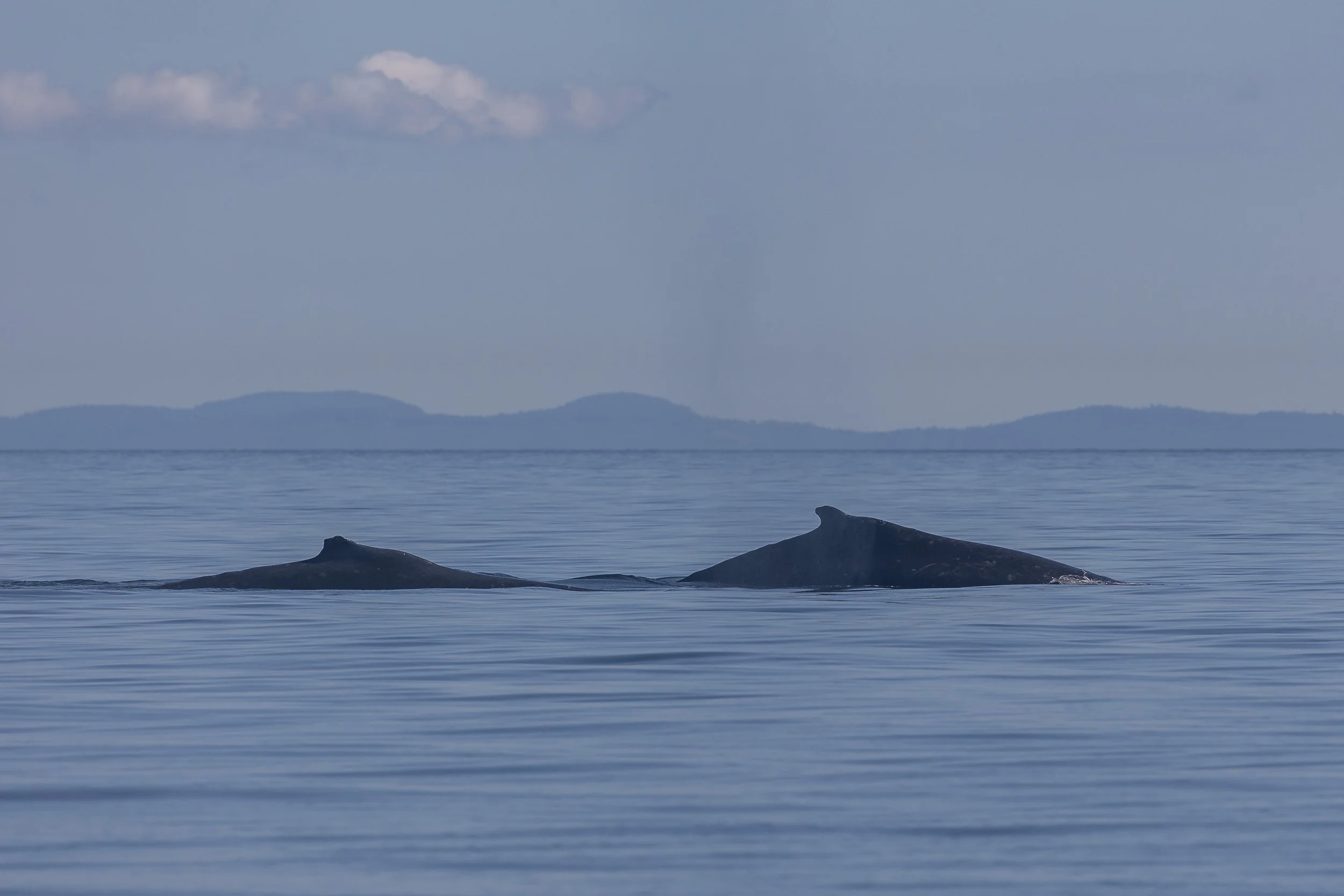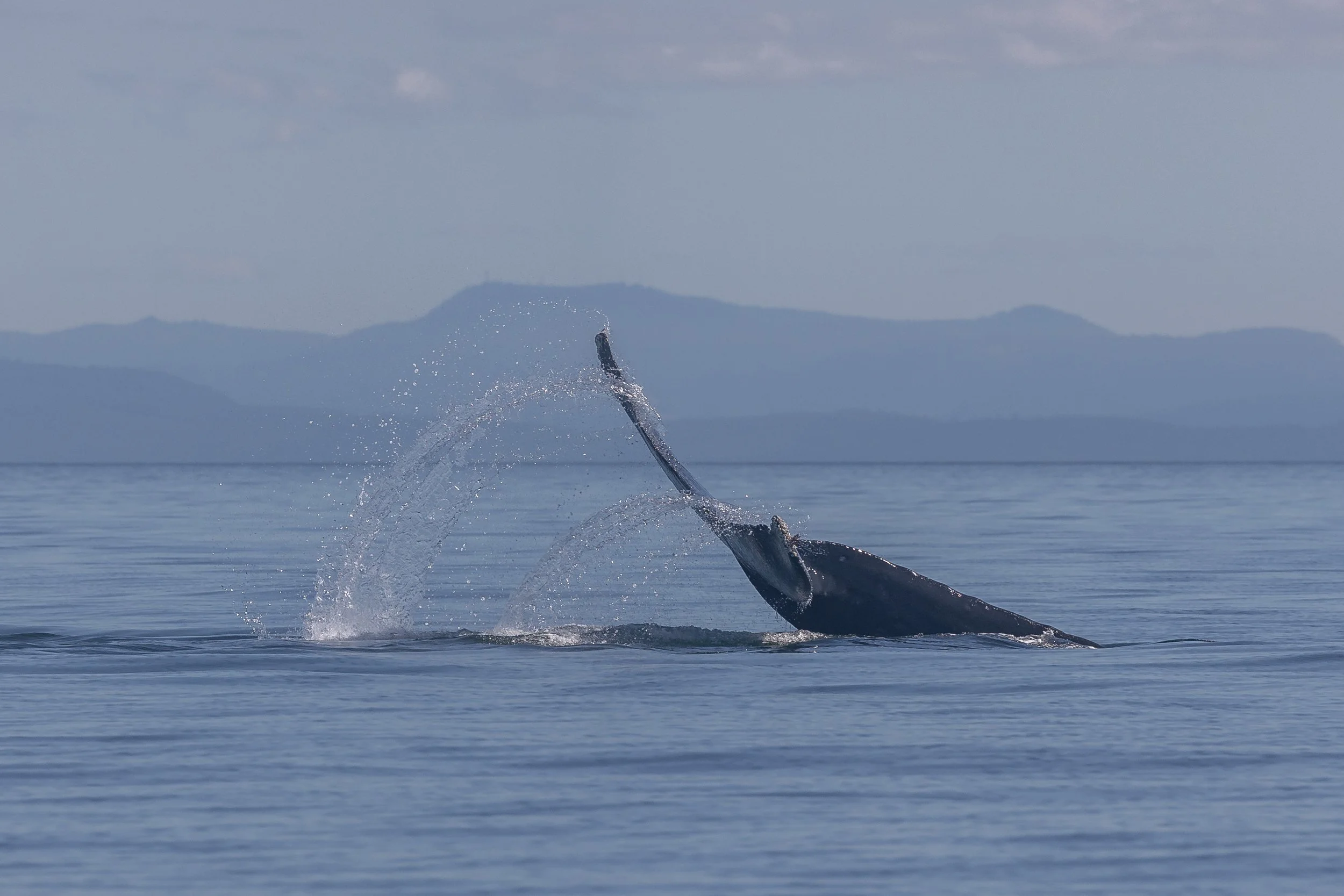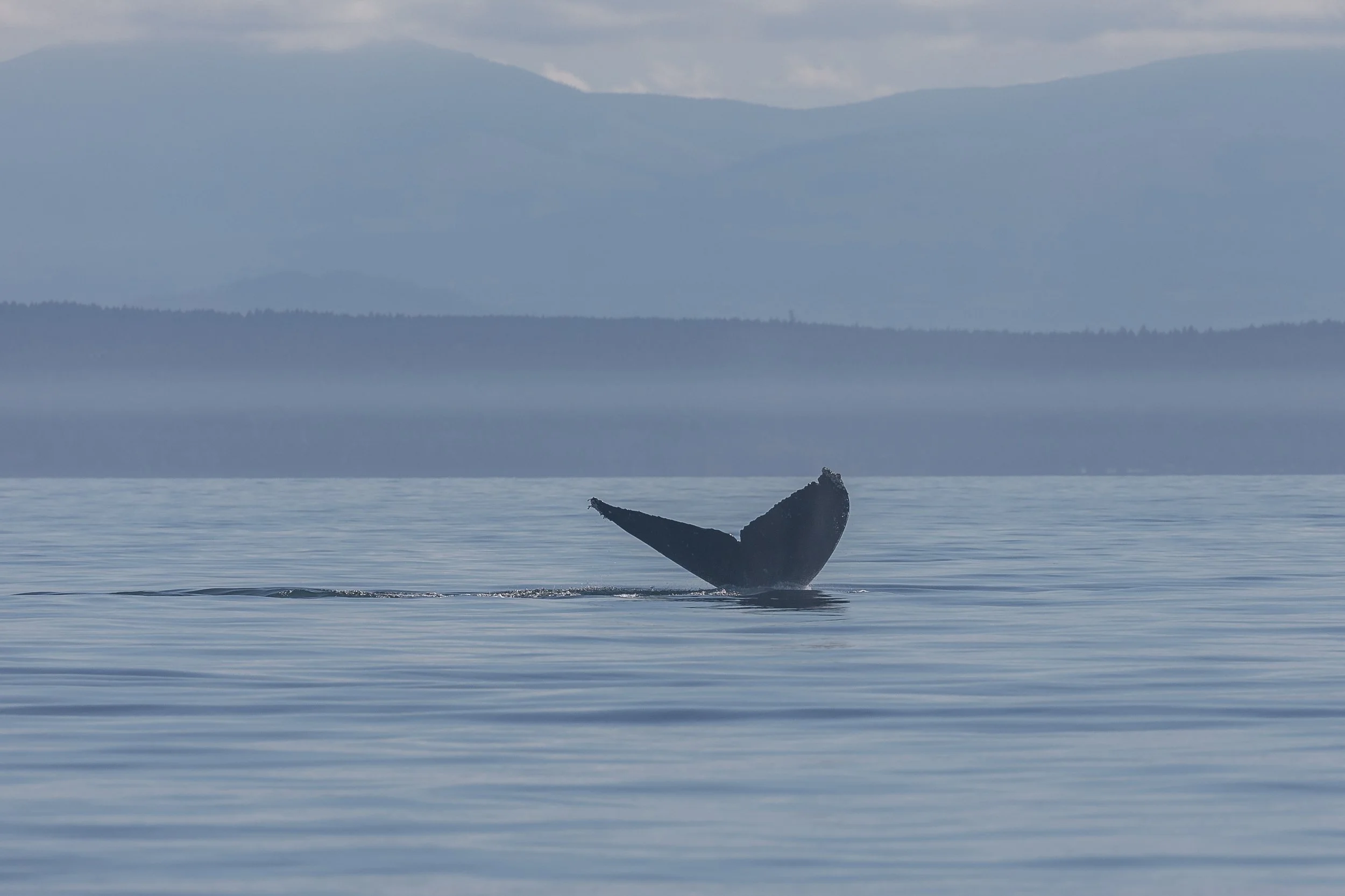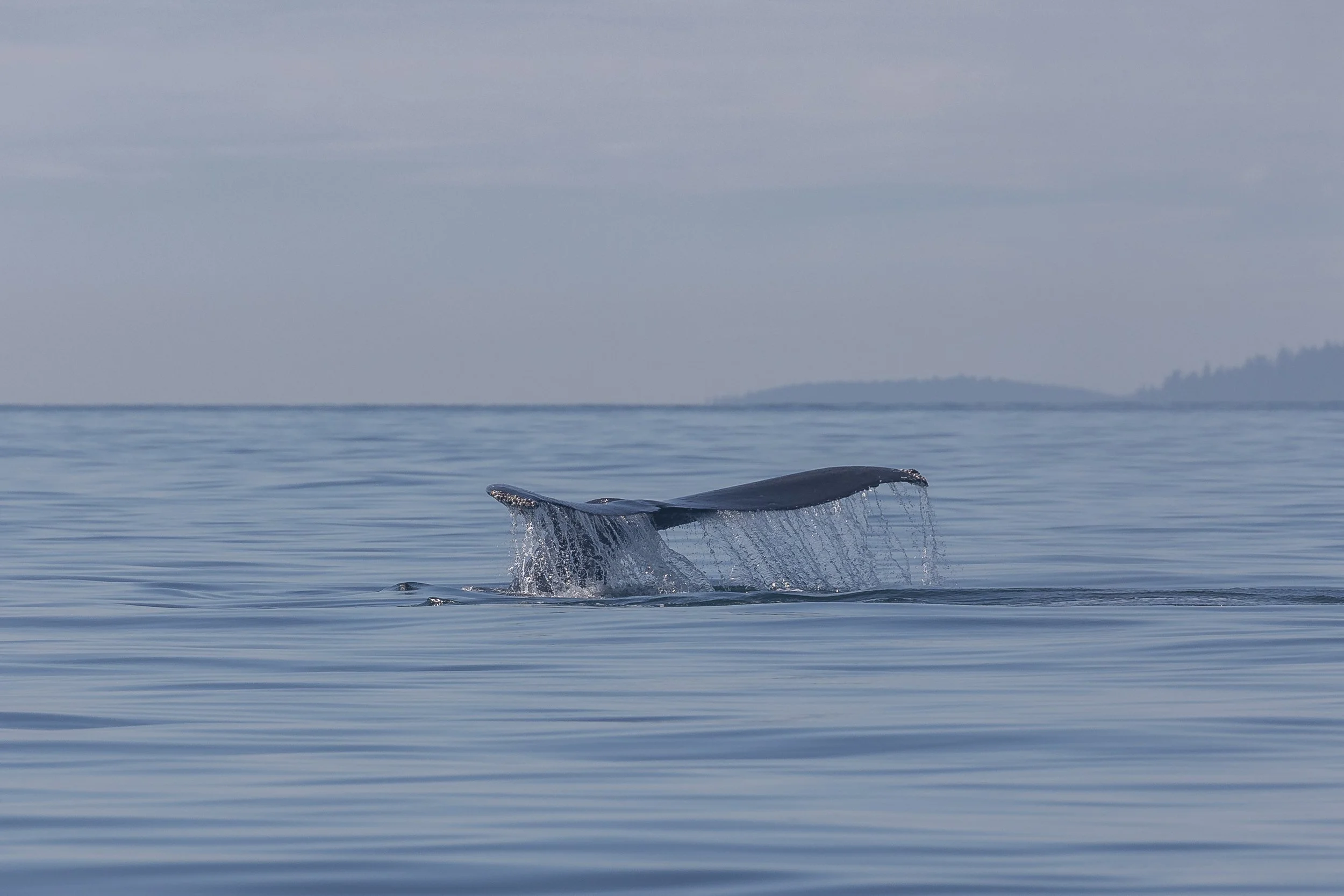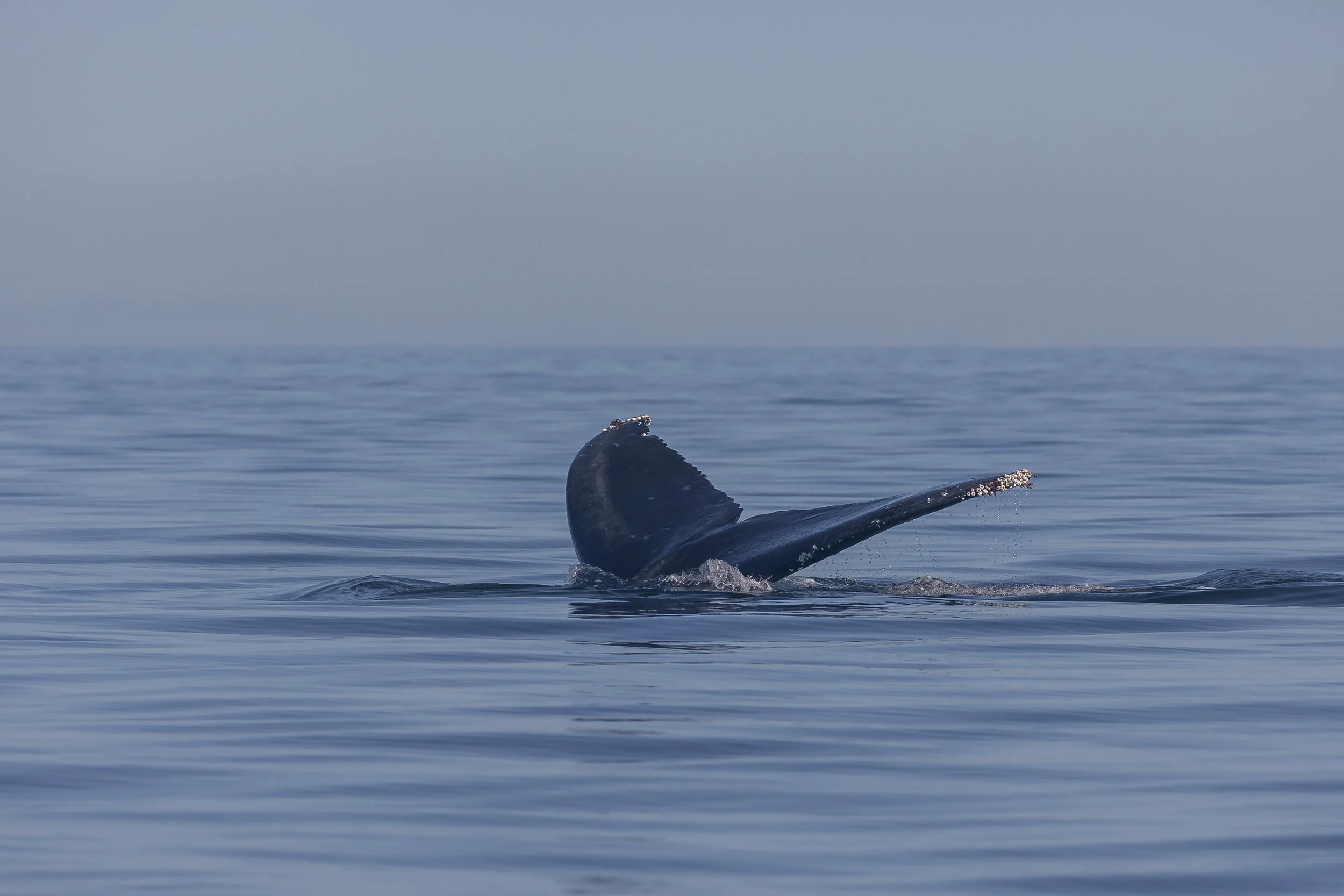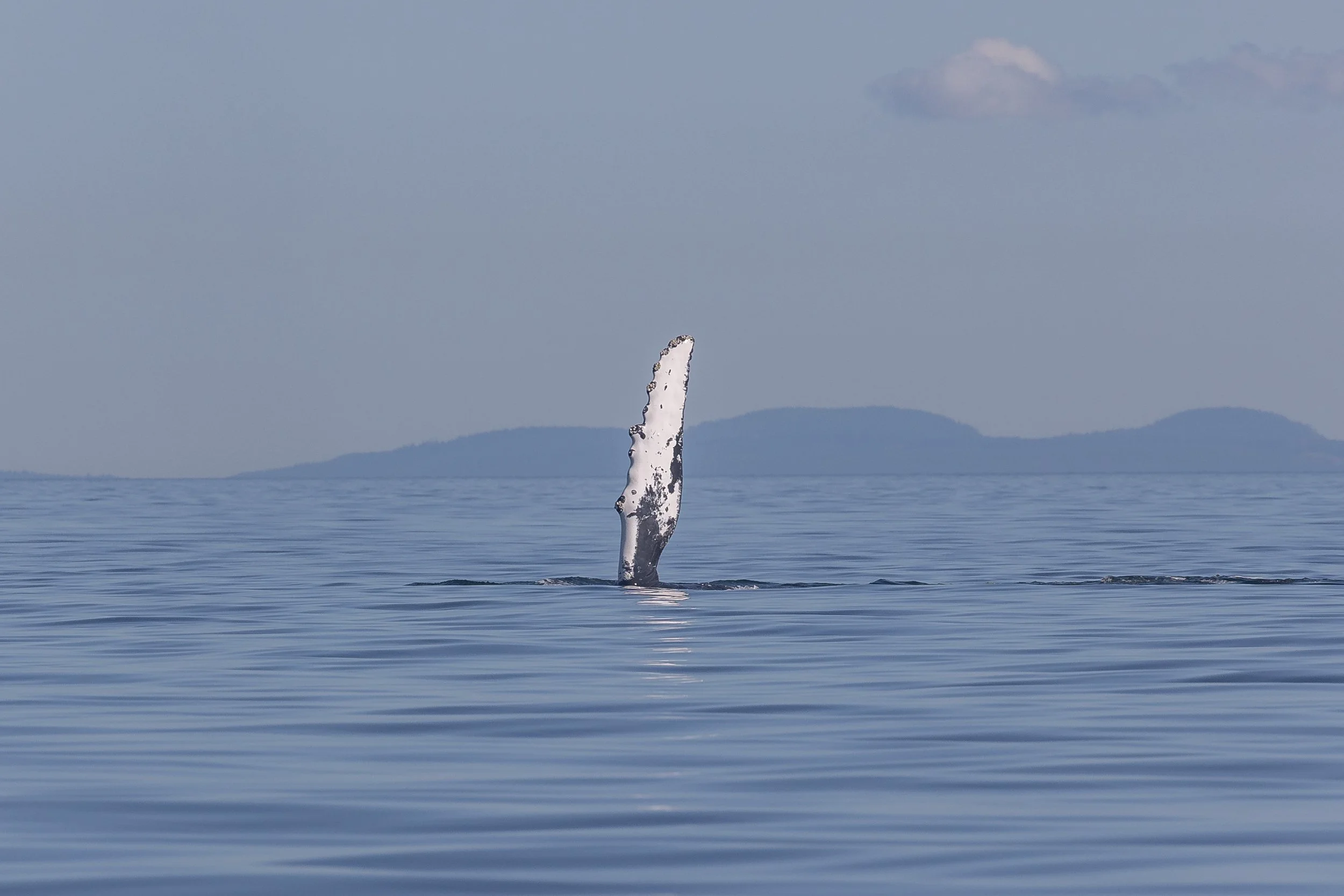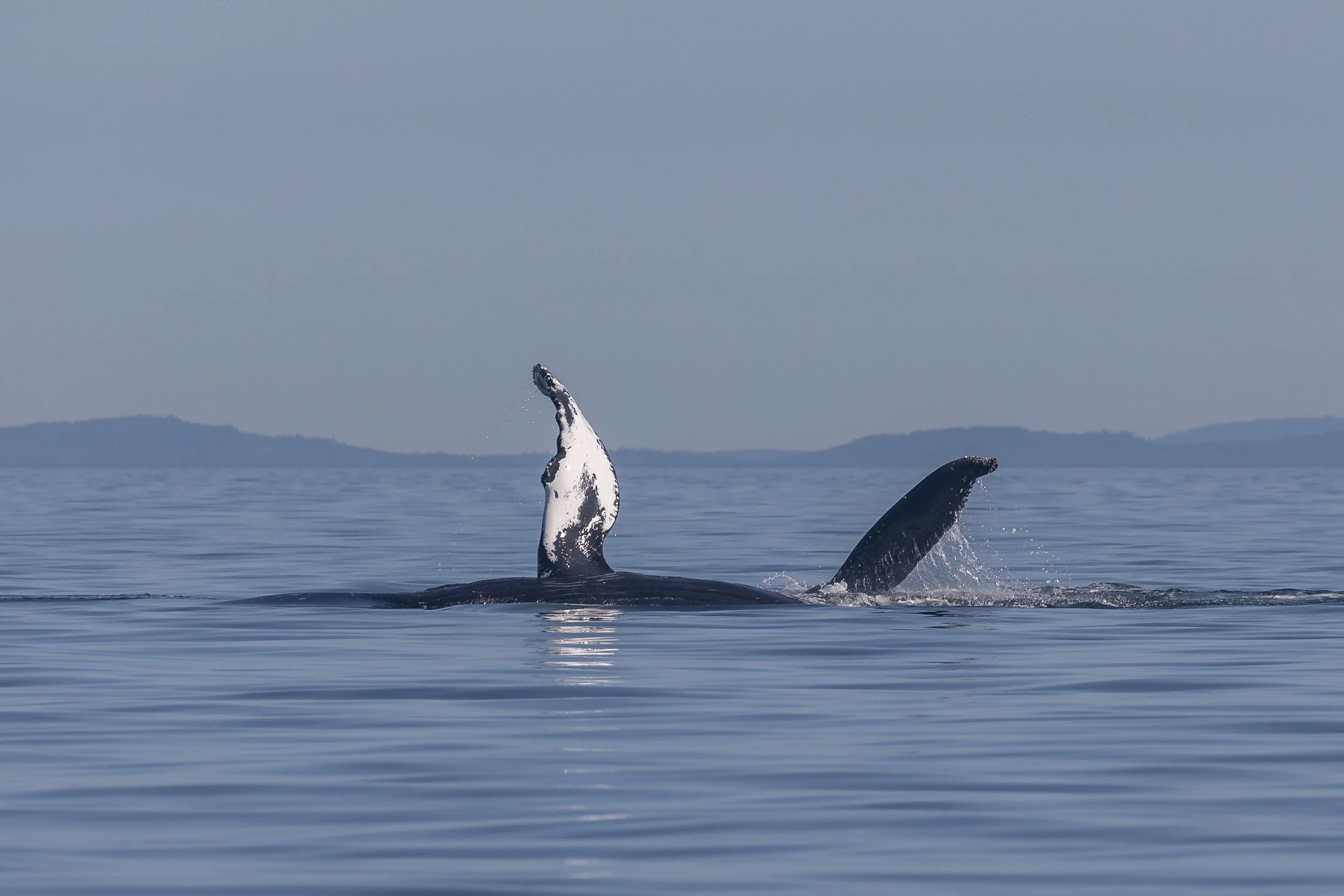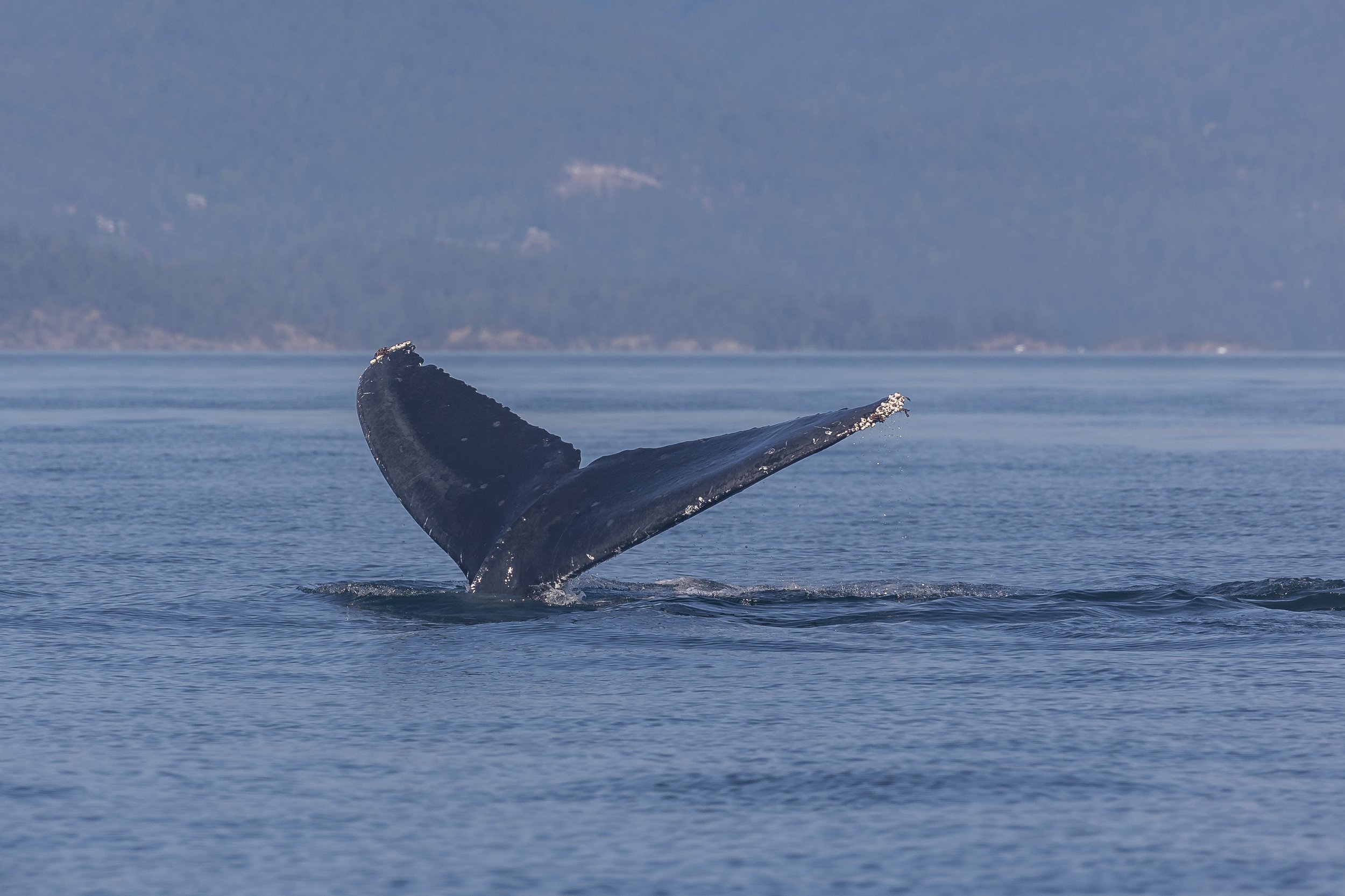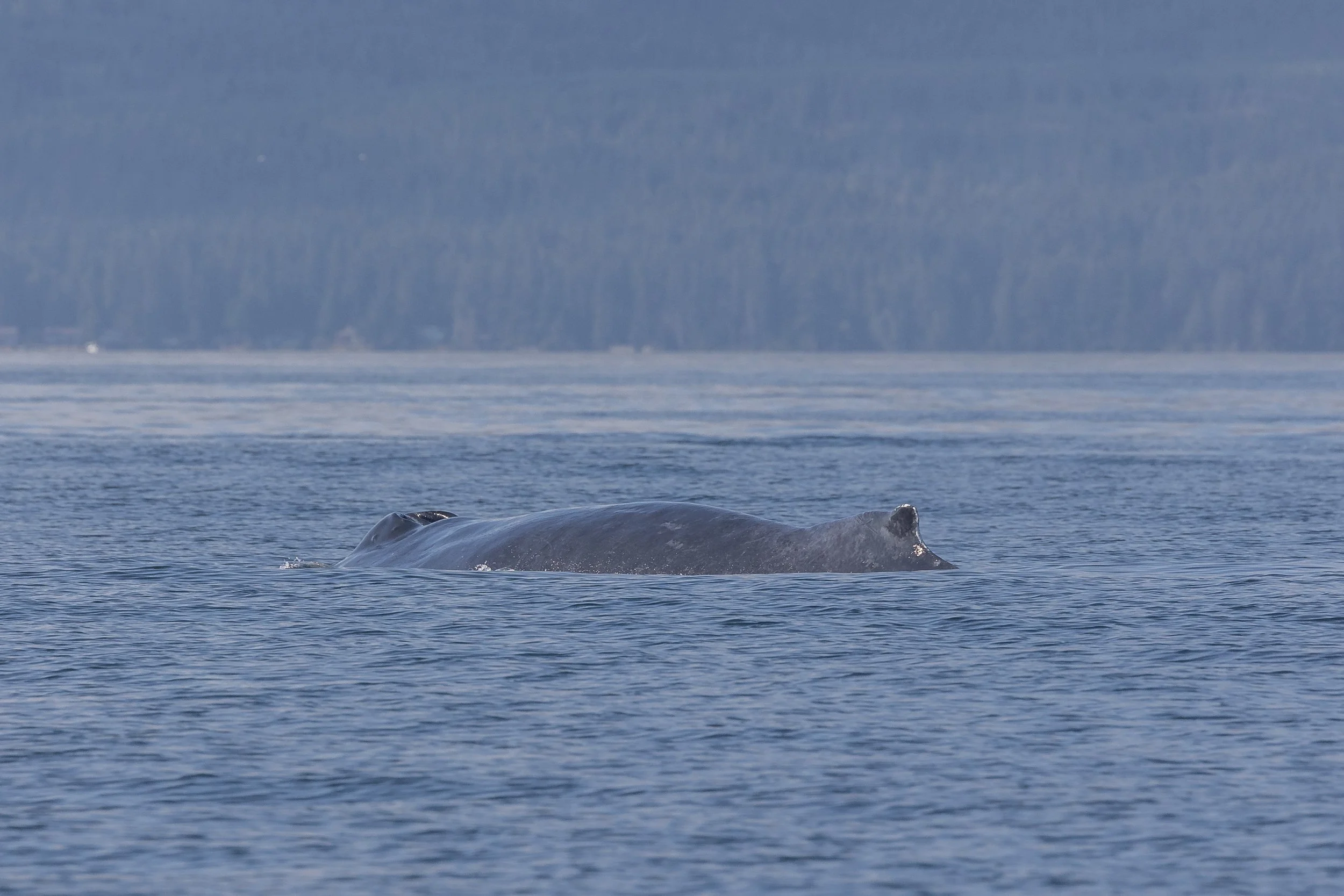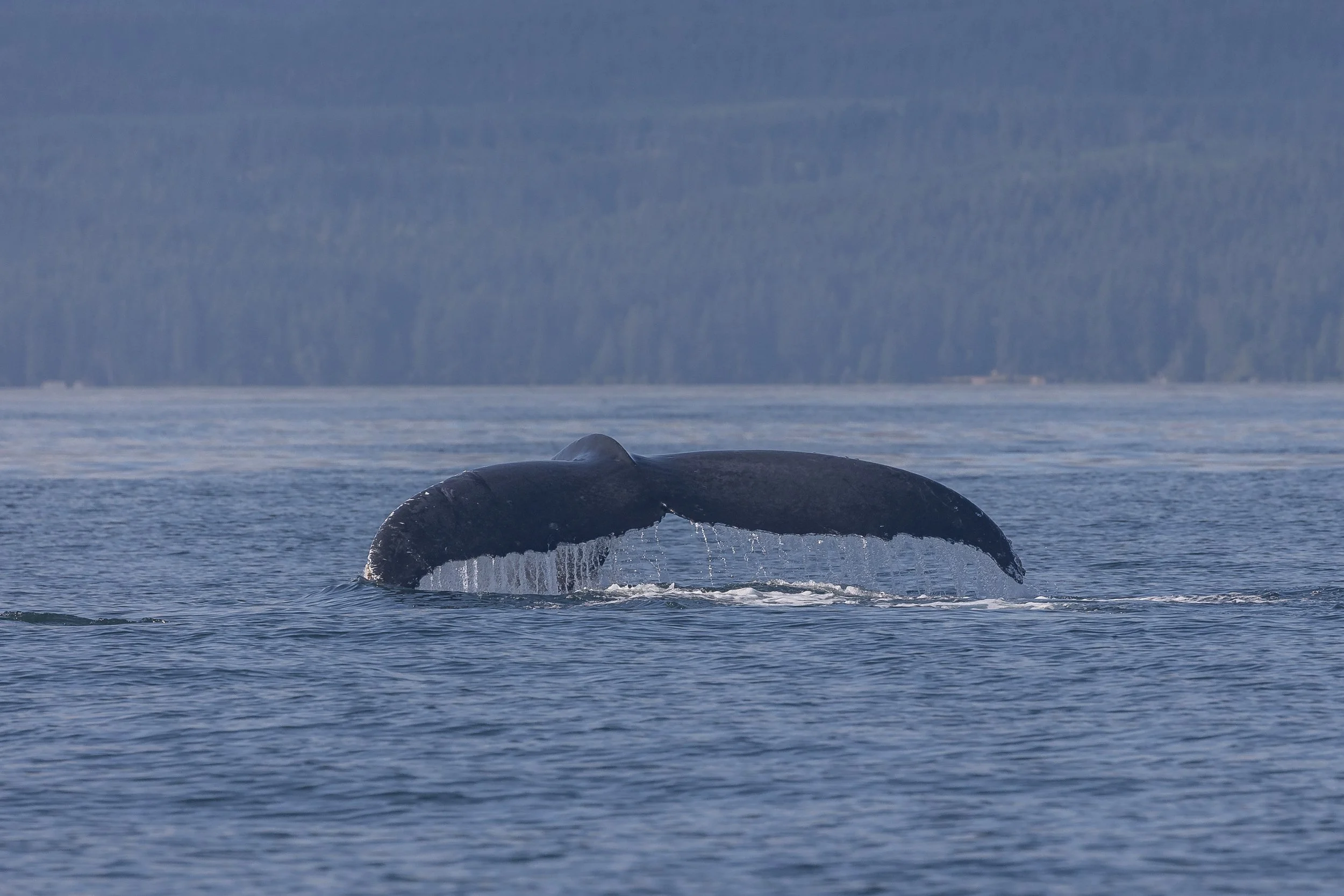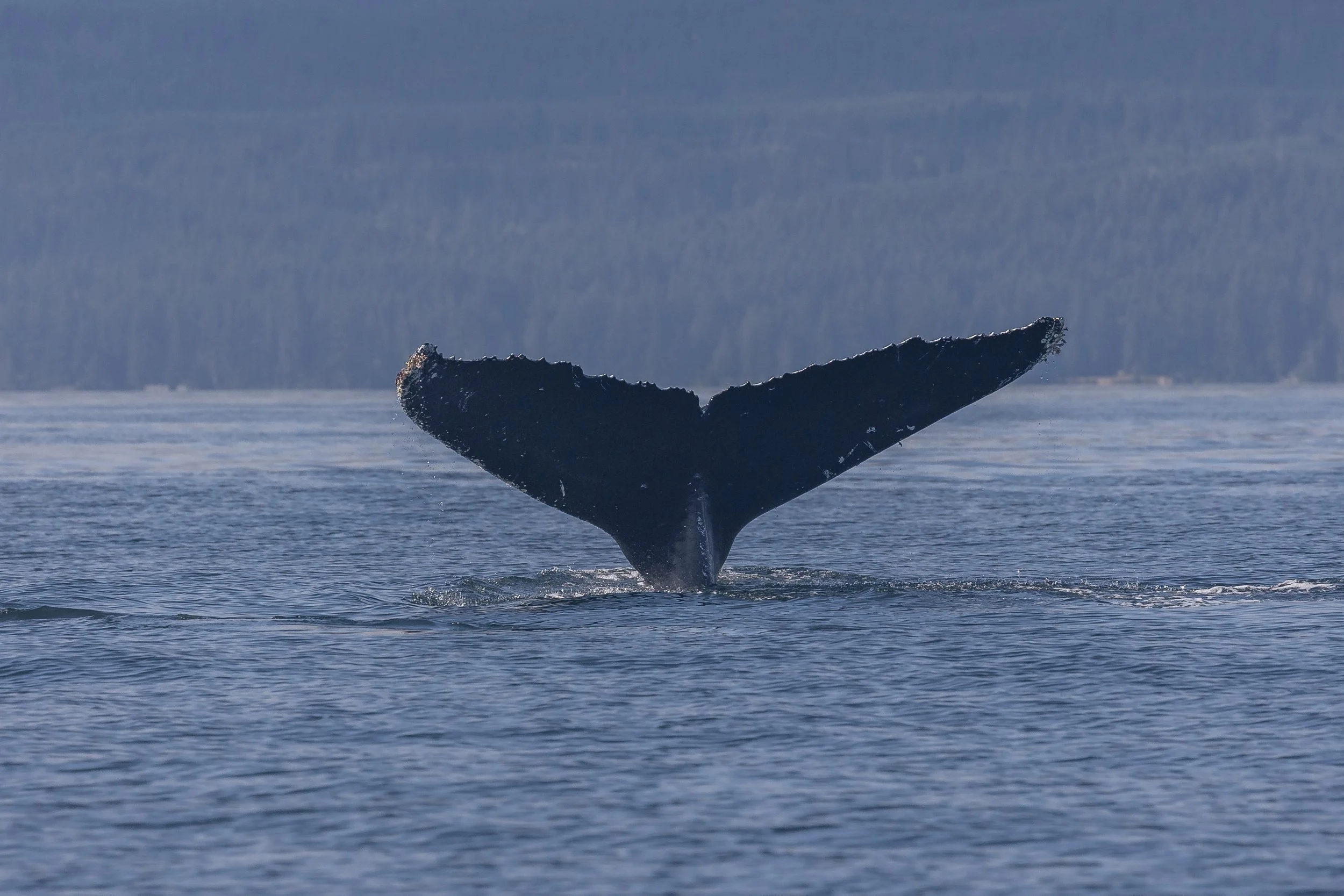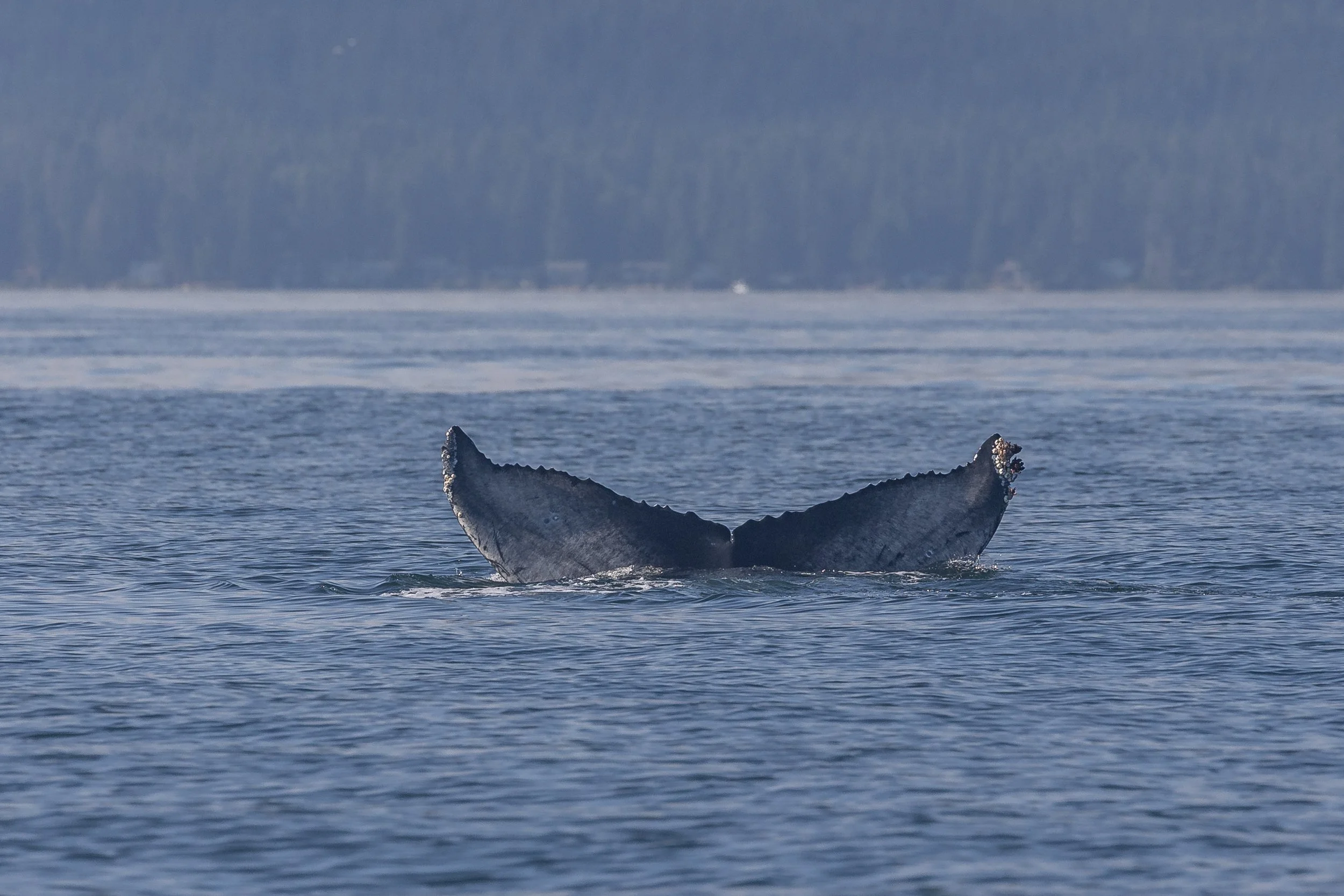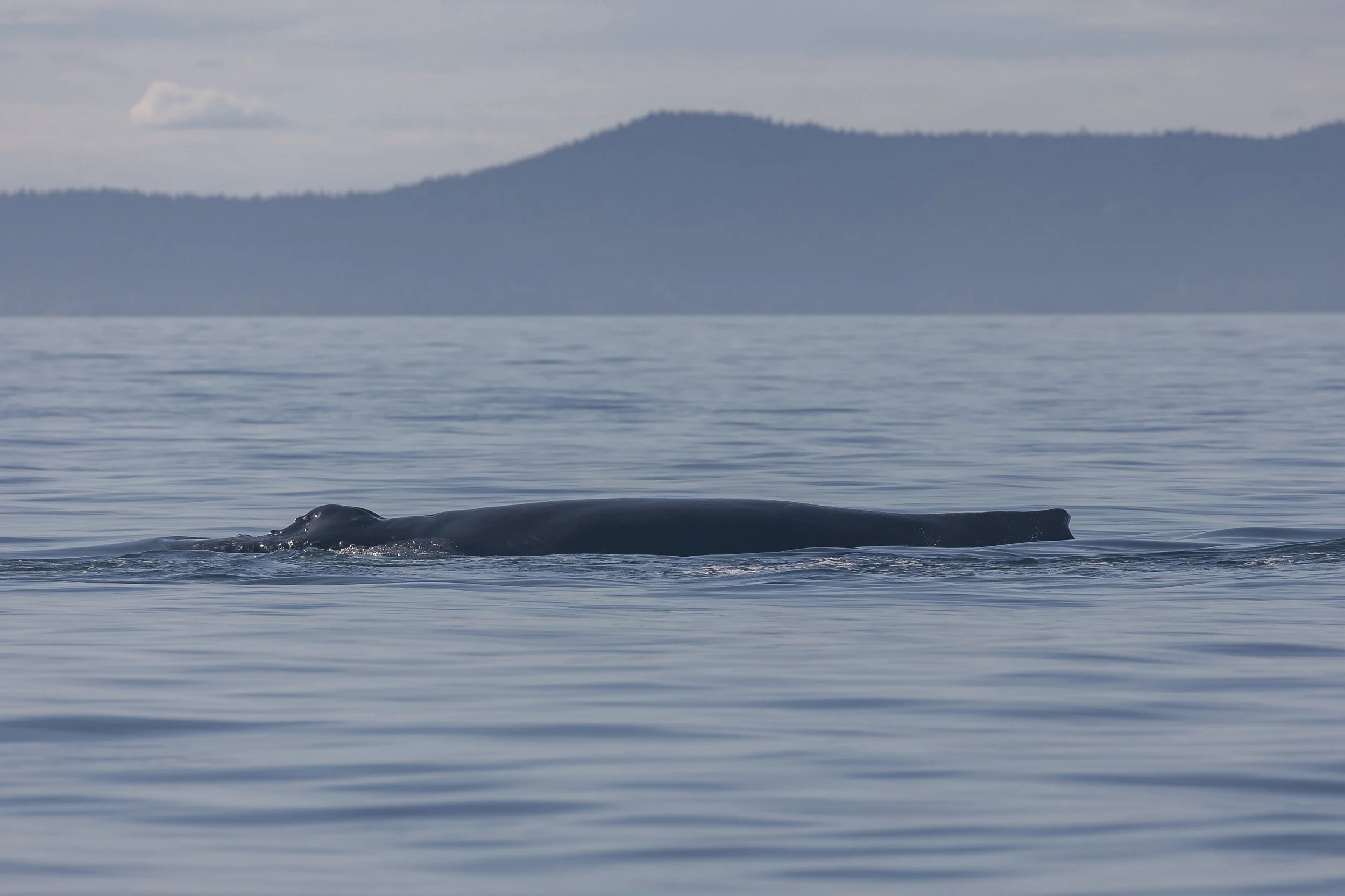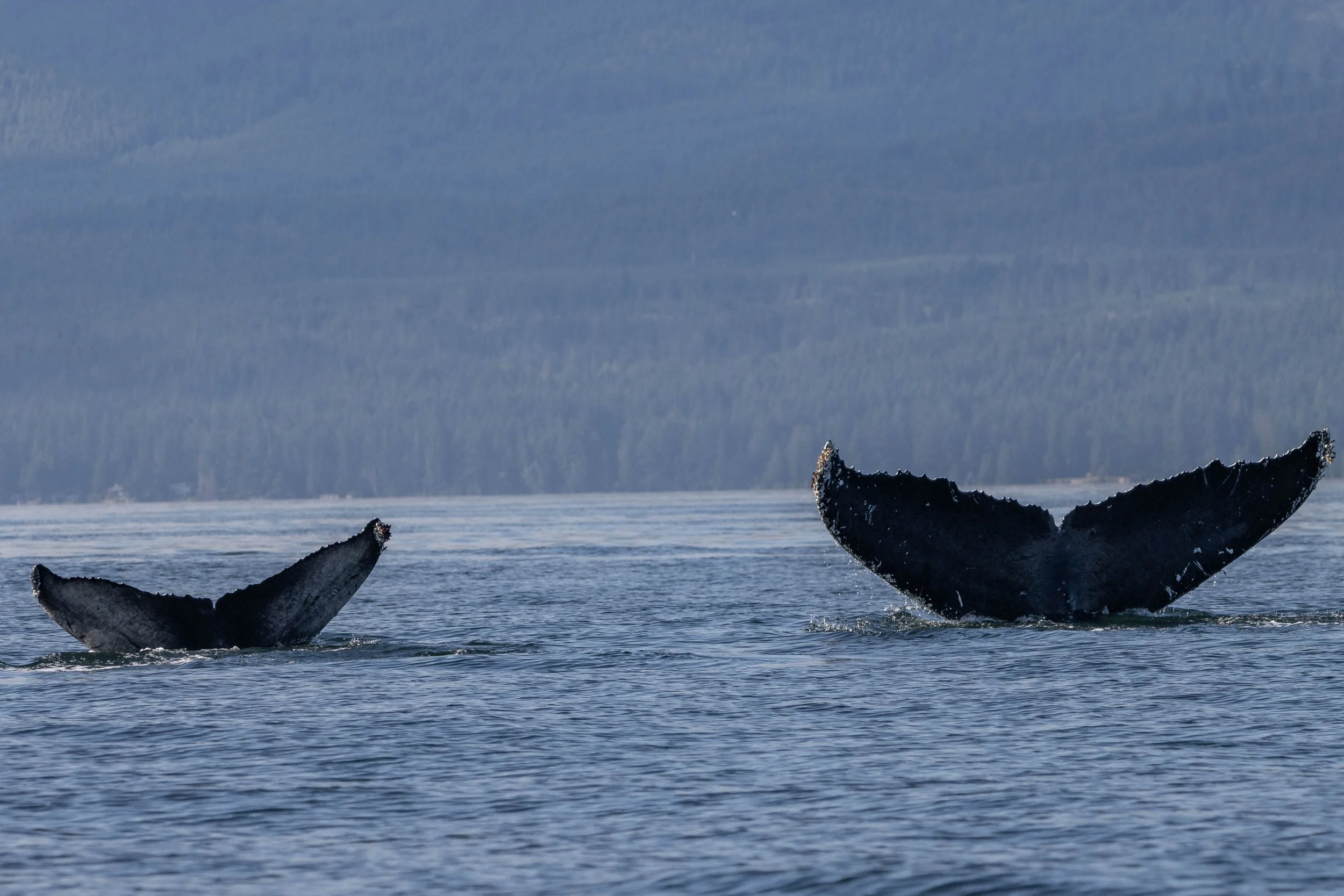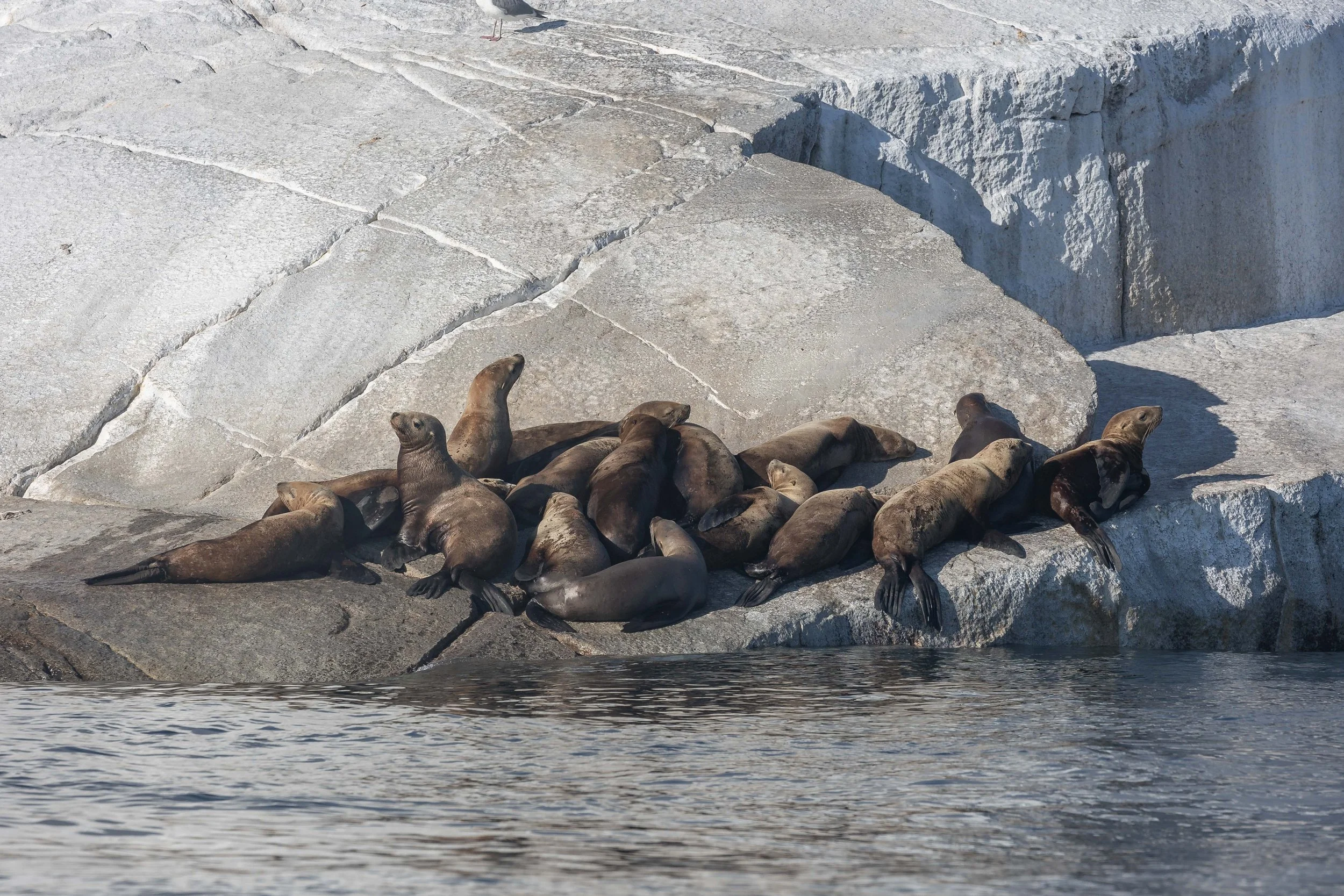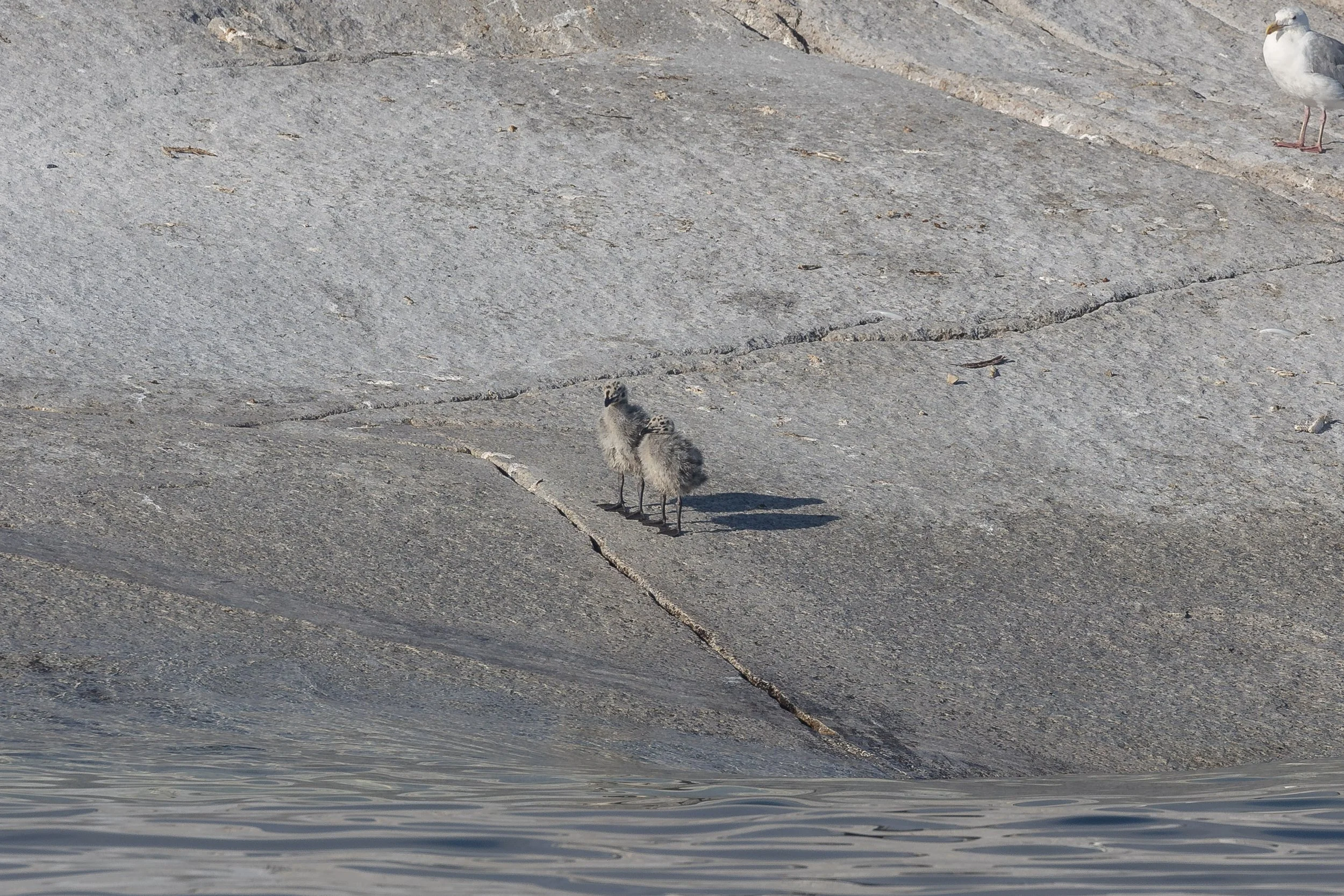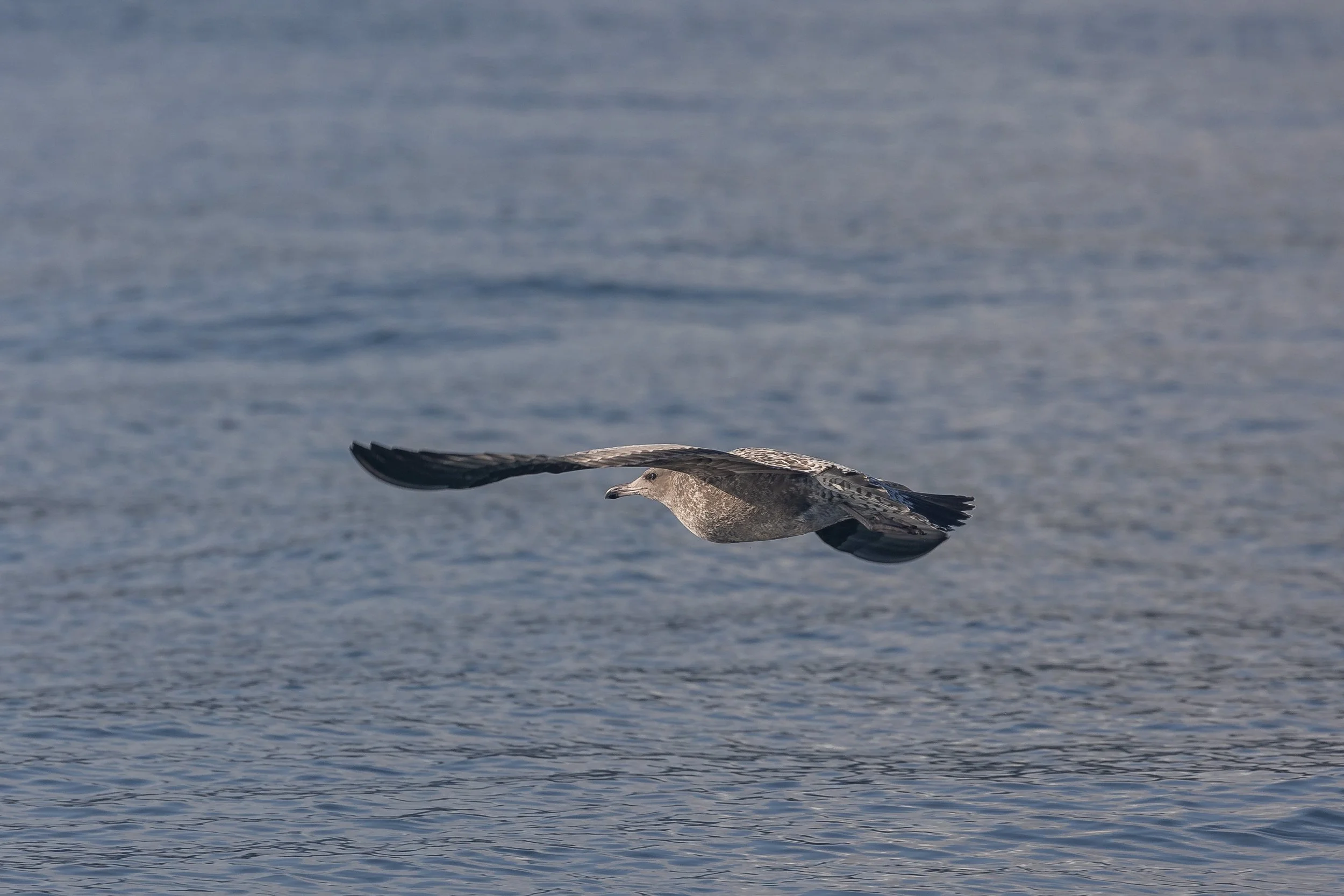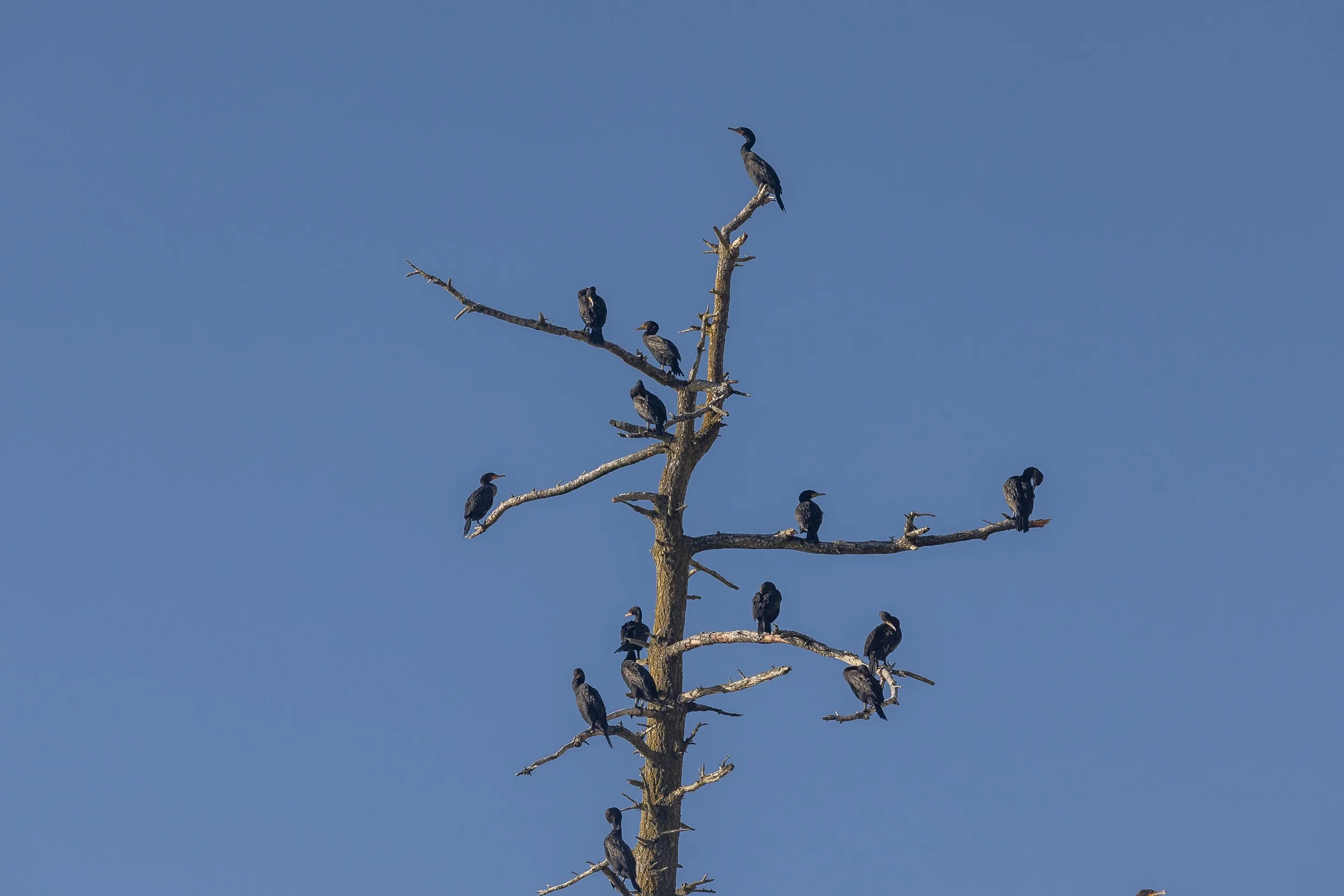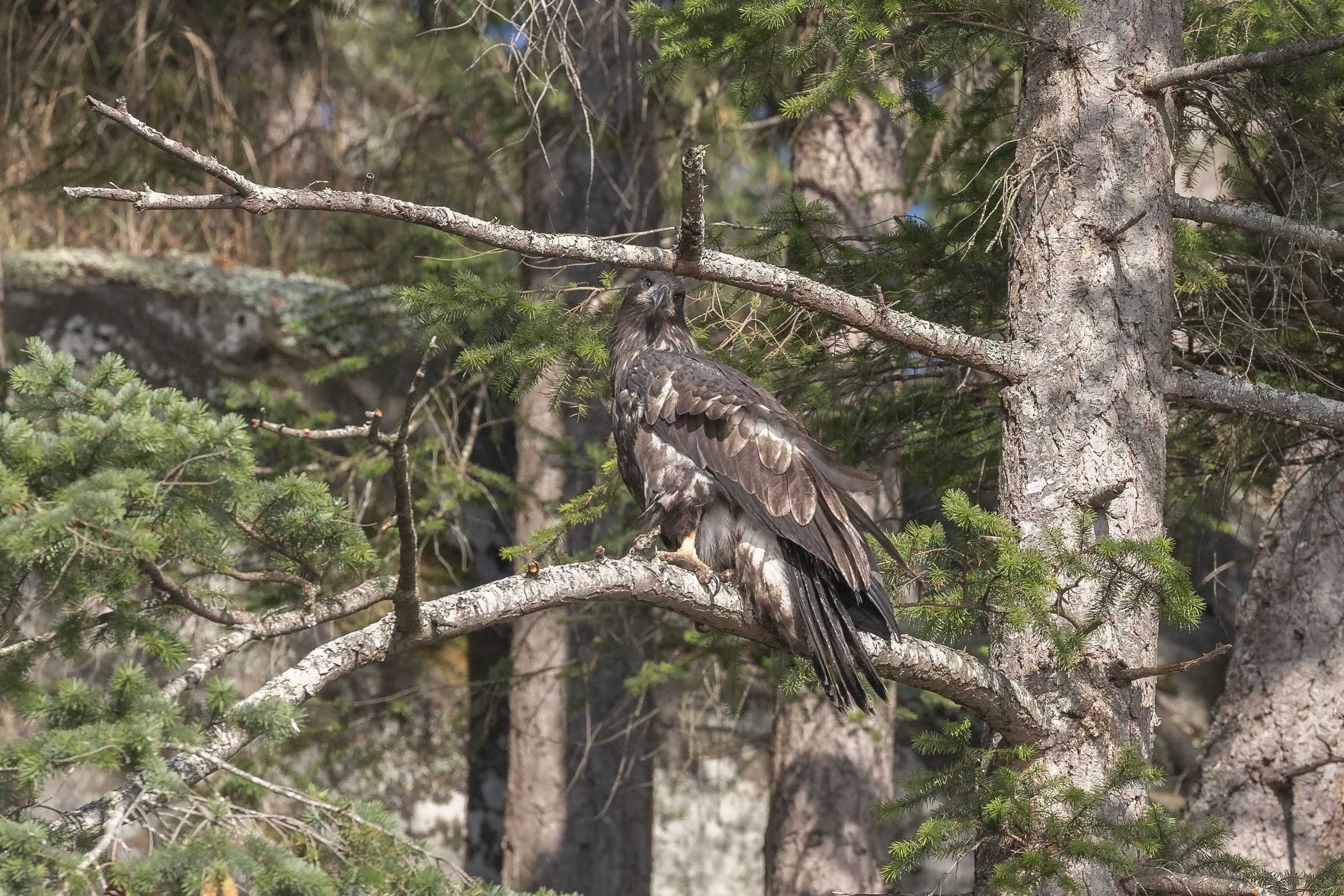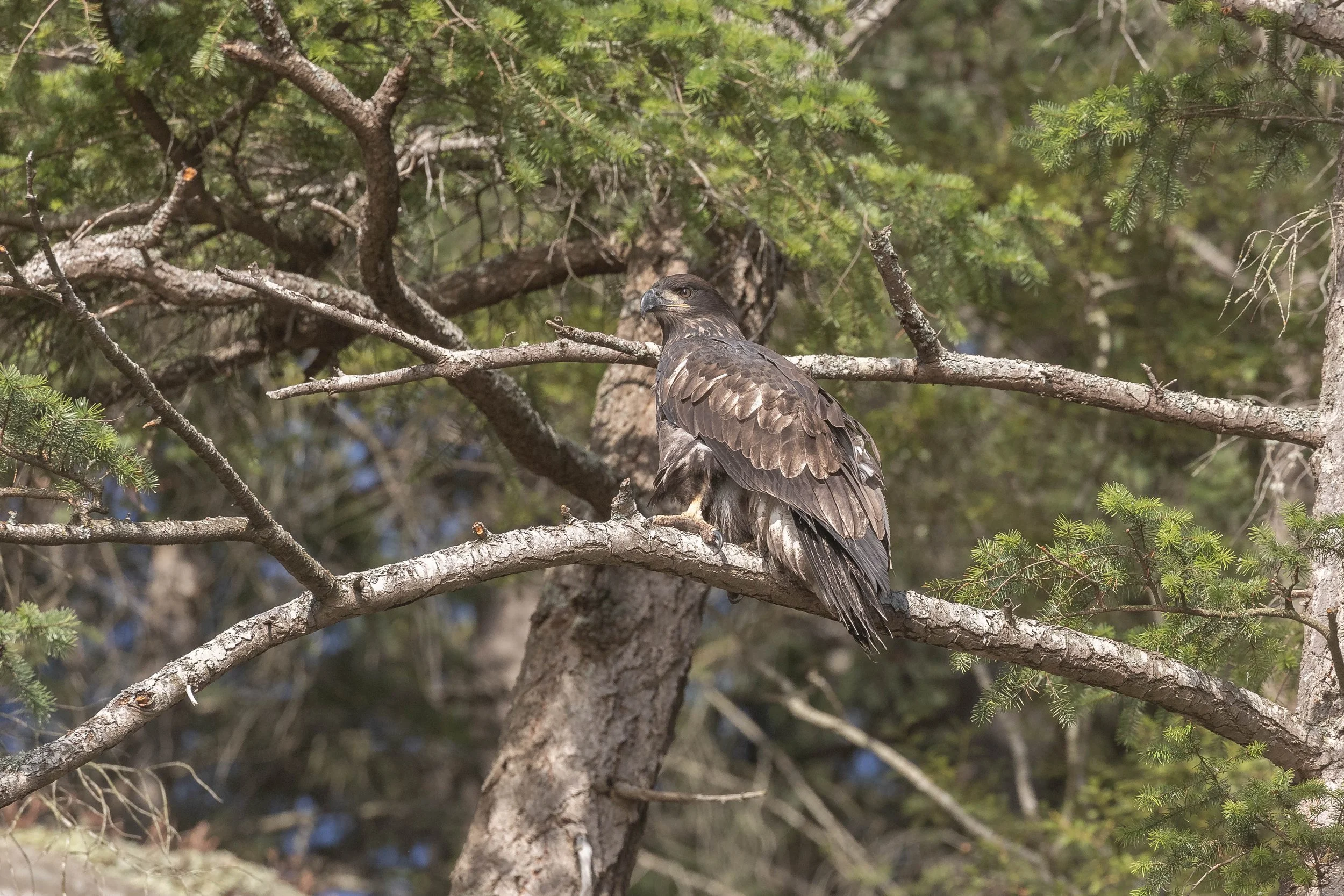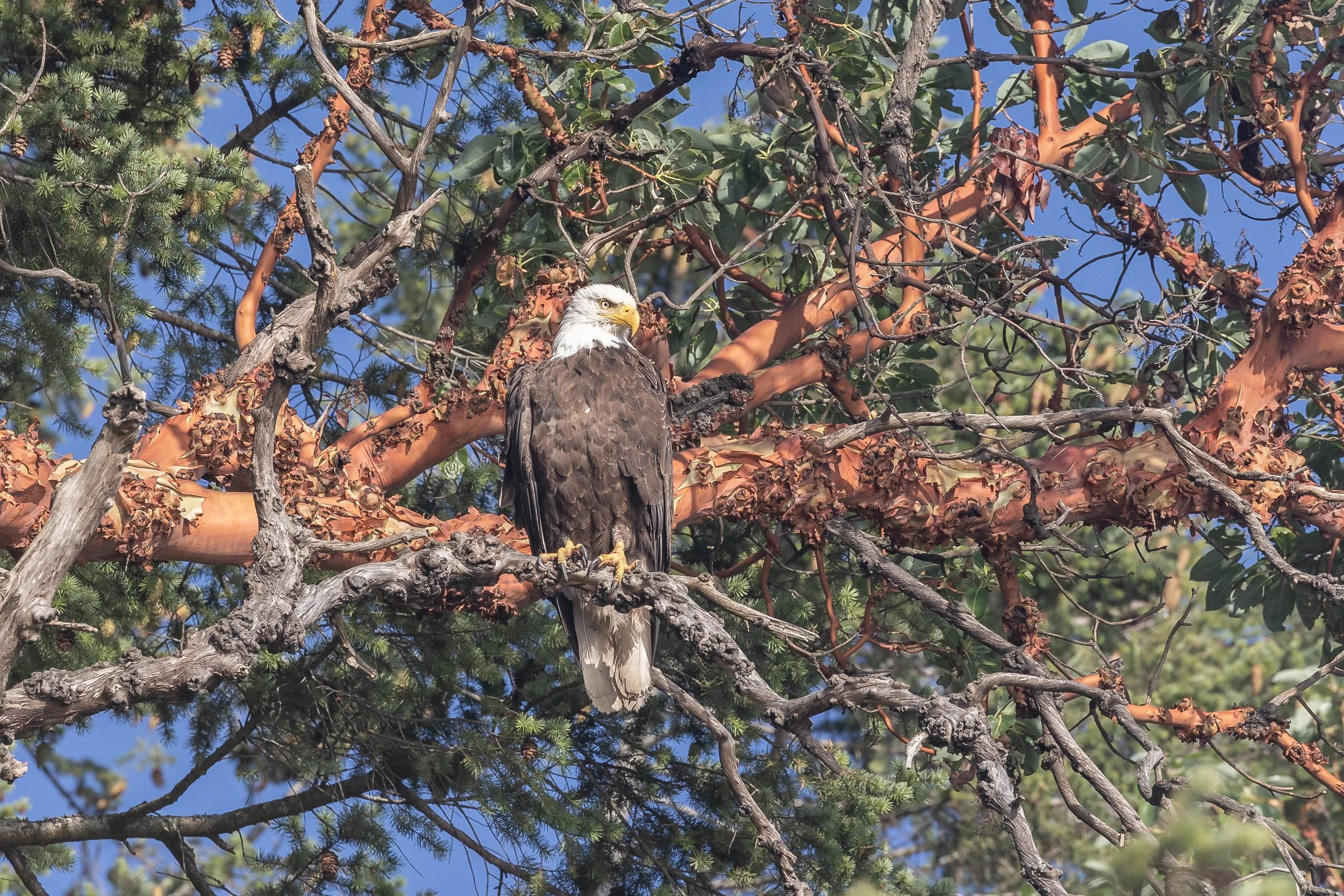July 31, 2024, 3:30 pm - Spending time with Humpbacks around Halibut Bank
It was another beautiful afternoon as our open boat left the dock and headed out into the Strait of Georgia in search of whales. We started by heading over the North end of Gabriola Island, towards an area known as Halibut Bank, since that’s usually a good place to find wildlife. The conditions were near perfect, with calm water and clear skies, and made it easy to spot when a whale surfaced in the distance.
It was a humpback whale, letting out a huge blow when it released its breath at the surface in what is called a “blow”. This column of mist can reach heights of about 3 meters or the equivalent of one story of a building. You can imagine that this can be spotted from quite a distance given the right conditions! Even when there is some wind most staff don’t mind since the wind moving these blows makes it easy to distinguish it from something like a sailboat off in the distance.
There was no mistaking it today though, we had found ourselves some humpbacks! This first sighting turned out to be two whales travelling closely together: Bullet (BCX1658) and Crackle (BCY1227). These two seemed quite rambunctious, swinging their tails around at the surface, slapping their pectoral fins against the water, and even breaching a couple of times! It’s not super common to see this sort of activity from humpback whales, but as the season continues they keep building more fat reserves and tend to have more energy. When they first return to our waters they are very hungry, so most of their energy is focused on feeding instead of playing/socializing like this!
We watched in awe as they threw their 44-ton bodies out of the water, and swung the 5-meter-long pectoral fins around. Sometimes you forget how powerful these amazing animals are, but examples like this are good reminders. Each day they eat about a ton of food, which helps give them this sort of energy. It’s estimated that they use about 2% of their daily energy each time they breach, which is a lot for a single activity!
We stayed with these two for about an hour, before it was time to leave them to their surface activities and we headed out to see who else was in the area. It didn’t take long for us to find our next set of whales. This time it was what was usually expect to see from humpback pairs traditionally; a mom and a calf. These two were diving together, likely feeding on the clouds of Krill and fish that would be found in the area. Thanks to them lifting their tails for these dives we were quickly able to identify Tempest (BCX0837) and her 2024 calf. These two were super adorable to watch, given the size difference. Tempest has been recorded in our area since 2004, making her at least 20 years old and therefore fully grown. That means that she would be about 17 meters long and weigh up to 44 tonnes. That’s a big girl! Her calf would’ve nearly doubled in size since being born now thanks to Tempest’s very rich milk, with about 70% fat content. This amount of energy passing to the calf through milk means that Tempest has much higher energy requirements than other humpbacks not nursing, and would need to eat about 1.5 tons of food every day instead. We don’t often see mother humpbacks being too active at the surface because of these high requirements and instead most often see them feeding. The calves on the other hand have more energy to spare thanks to Tempest’s hard work so sometimes they will party while mom feeds. Today though, it seems like Tempest’s 2024 calf wanted to be a mini-me to their mother, diving and lifting their tail alongside mom. It was nearly the cutest thing we have ever seen! Even though they are so huge, babies of any size still capture our hearts.
While we were watching this duo feeding in the area, Beak (BCX1606) did a drive-by, showing up for one surface, giving a perfect fluke, and then disappearing below the surface.
Soon it was also time to leave these whales behind, and we headed over to the White Islets to get a look at the Steller Sea Lions that haul out there. These are also giants in their own right, being the largest species of Sea Lion in the world, and the third largest Pinniped. Not every sea lion shows off this size though, just the Adult males that can reach about 2,500 pounds when fully grown. To put it in perspective, that’s about the same weight as a Toyota Corolla! Catching our eye at White Islets were also all of the birds spending time along the shore. There were Black Oyster Catchers, Harlequin Ducks, and of course, all the gull chicks from the nests along the rocks! It has been so great to watch the progress of these little guys growing up on this little island.
Finally, we headed back towards the Nanaimo Harbour, but wait, was that another blow? We got one more humpback that showed up at the end of the tour, also giving one fluke before going for a dive. Although the only photo we got of this little whale was slightly out of focus, we are fairly confident that it was Graze’s 2023 calf (BCY0523calf2023). They have a big dark spot on the left side of the underside of their tail that we are pretty sure that we saw. We didn’t stick around with them, since we were running short on time. We continued on to Nanaimo, with a quick stop at the Gabriola Bluffs. Here we not only got to see more baby animals in the very unique-looking chicks of the Cormorants, but we also saw Greyson, the young bald eagle that was raised by Bonnie and Clyde this year. He and one of his parents looked down at us from the branches overhead.
After seeing all of that wildlife, we were very happy returning to the docks in Nanaimo. The onboard naturalist Hayleigh Hilbert and ride-along staff member Lucy Willis got some amazing photos from the day which can be viewed below!
Bullet on the left with Crackle on the right. Photo by Hayleigh Hilbert.
Bullet flicking her tail. Photo by Hayleigh Hilbert.
Bullet was flinging the water around with her tail slaps. Photo by Hayleigh Hilbert.
Bullet diving under the surface on this hazy afternoon. Photo by Hayleigh Hilbert.
Crackle creating a fluke waterfall as they dive. Photo by Hayleigh Hilbert.
Crackle’s dorsal surface as they arch to dive. Photo by Hayleigh Hilbert.
Bullet surfacing in front of Crackle as their blows create a rainbow. Photo by Hayleigh Hilbert.
Crackle surfacing behind Bullet. Photo by Hayleigh Hilbert.
Bullet lifting their tail with Vancouver in the background. Photo by Hayleigh Hilbert.
Bullet’s tail flukes dipping under the surface. Photo by Hayleigh Hilbert.
Look at the sun reflecting off of this humpback’s pectoral fin! This is likely Crackle. Photo by Hayleigh Hilbert.
(probably) Crackles pectoral fin. Photo by Hayleigh Hilbert.
Crackle pec slapping with Bullet beside them. Photo by Hayleigh Hilbert.
Crackle fluking in front of Bullet’s back. Photo by Hayleigh Hilbert.
Bullet diving. Photo by Hayleigh Hilbert.
The underside of Crackle’s tail flukes as they dive. Photo by Lucy Willis.
Crackle slapping their tail. Photo by Lucy Willis.
Crackle flicking their tail. Photo by Lucy Willis.
Tempest surfacing. Look how big she is! Photo by Hayleigh Hilbert.
Tempest lifting her tail on a dive. Photo by Hayleigh Hilbert.
The underside of Tempest’s tail. Photo by Hayleigh Hilbert.
The underside of Tempest’s 2024 calf’s tail. Photo by Hayleigh Hilbert.
Tempest preparing for a dive. Photo by Hayleigh Hilbert.
Tempest creating a fluke waterfall. Photo by Hayleigh Hilbert.
Tempest’s 2024 calf surfacing. Photo by Hayleigh Hilbert.
Tempest on the right diving next to her calf on the left. So cute! Photo by Lucy Willis.
Steller Sea Lions on the White Islets. Photo by Hayleigh Hilbert.
The baby gulls here are growing up so fast. Photo by Hayleigh Hilbert.
A couple of gull chicks. Photo by Hayleigh Hilbert.
So many oyster catchers on the White Islets. Photo by Hayleigh Hilbert.
A gull fly-by. Photo by Hayleigh Hilbert.
Graze’s 2023 calf diving. Photo by Hayleigh Hilbert.
Cormorants perched on a dead tree. Photo by Hayleigh Hilbert.
Some very ugly baby Cormorants. Photo by Hayleigh Hilbert.
A gull chick calling out for mom. Photo by Hayleigh Hilbert.
Greyson giving a look to the boat. Photo by Hayleigh Hilbert.
Greyson perched nearby to the nest. Photo by Hayleigh Hilbert.
One of the adult bald eagles on the Arbutus Tree. Photo by Hayleigh Hilbert.

